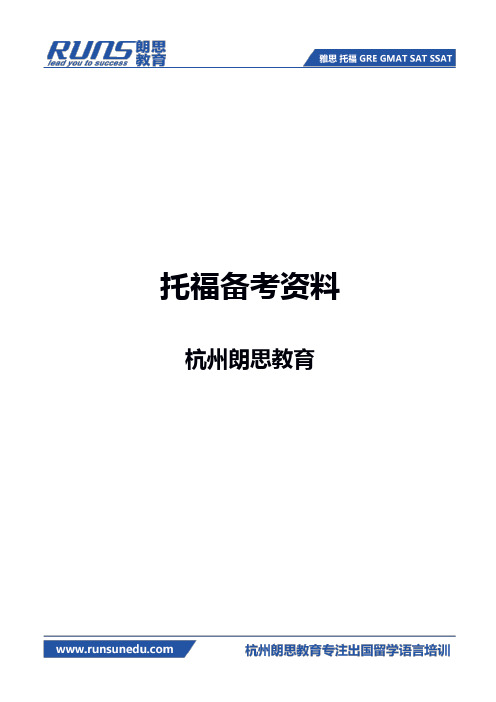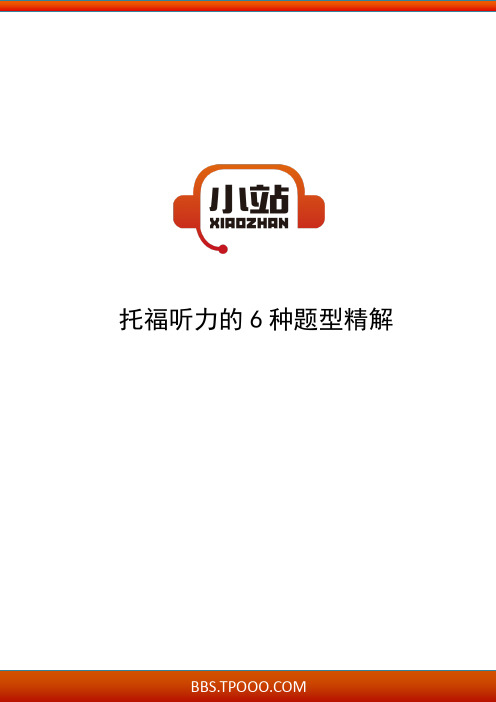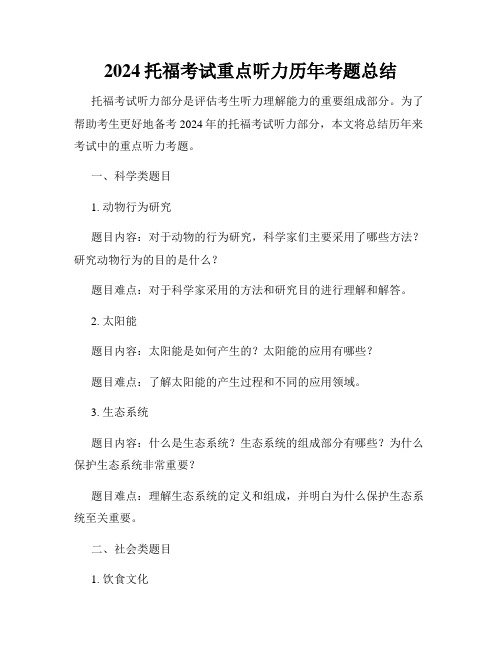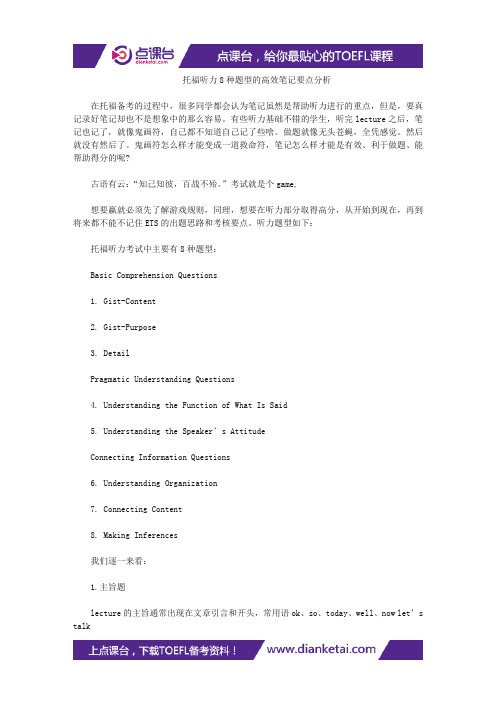托福听力排序题考点精析
托福听力题型十大解析

托福听力题型十大解析在托福听力考试中,对于题型的把握非常重要;它对于理解句子的正确意思起着致命的作用;下面托福频道给大家做进一步解析。
1) BUT题型。
这类题型在托福题中层出不穷,根本每一套托福题中都会有三、四、五道不等,这类题型解题关键是努力听懂but 后面的东西,因为这个地方永远是考点。
对一般考生而言,让他将所有的东西都听出来不大可能,因为实力不够。
但假设是让他听出其中的一点,那就没什么问题。
而but 恰恰就是这样一个标志,听见but就该使劲了,一使劲问题也就解决了。
试看几例:a) Does this music bother your studying, Pam?Actually I’m not studying any more, but I’m trying to sleep. ( 年1月第23题) b) Gee, Tom, I hear that you are working as a house painter this summer. It’s got to be awfully hot working up there on a ladder in the blazing sun all day.Well, it’s hard work, but I get to be outdoors and the pay is decent. ( 年1月第9题)c) I don’t think I want to live in the dormitory next year. I need more privacy.I know what you mean. But check out the cost of renting an apartment first, I wouldn’t be surprised if you changed your mind. ( 年1月第30题)2) 对一般疑问句答复题型。
杭州朗思!托福听力的13个出题点及解析

托福备考资料杭州朗思教育杭州朗思!托福听力的13个出题点及解析很多同学提到托福听力笔记的问题,觉得非常头疼。
其实托福听力笔记的重要性不仅仅体现在听力部分,其实更重要的是在后面口语和作文部分。
没有好的笔记练习和积累,会给考生造成很大的障碍。
在听力部分,其实85%的精力应该放在听上面,大家应该完成以下的过度:记中听(什么都记)——边听边记(有选择的记)——听中记(边听偶尔记)。
对于很多”疯牛“级别的考生,甚至在听力部分不记笔记,全凭记忆,练习到一定程度是可以达到的。
但是对于绝大多数同学来数,还是需要适当的记笔记。
面对新托福听力,我们要分析ETS的初衷——对考生实力和情商的考察。
我们在听的过程中,逻辑和结构是重中之重,在此基础上我们对于细节进行必要的速记。
所谓的细节也是相对细节而不是绝对细节。
提前预测考点的出现,有的放矢的记笔记。
为什么我们听母语听的很好,而第二语就相对较差,就是我们没有在听的过程中思考分析,对于信号词不敏感。
只是机械地被动地听,不是主动地有意识地听。
托福听力的出题点在什么地方呢?一般是以下部分:1、conversation:段落开头提到的原因必考,结尾的建议必考。
2、段落开头提到的本次主题必考。
3、段落中重复两次的地方必考。
通常为本节课的要点,师生各重复一次的地方必考。
注意在笔记中划双线,重复两次的名词必考,一般重复的名词是AB项的替换词。
4、段落中的强调句型,多引出分论点,是考点:This is the first time…One thing important is…The most important thing…You should remember/notice/bear in mind/keep in mind---conversation引出建议的句型5、针对上下文明显的肯定或者否定的回答必考。
definitely,abusolutely,exactly,it’s a good question,excellent question。
【TPO小站】托福听力的6种题型精解

托福听力的6种题型精解1:GIST QUESTION 主旨目的题➢ 什么是主旨目的题?主旨题分为内容主旨和目的主旨托福听力题型 主旨题 功能题 结构题 细节题 推理题态度题➢如何识别主旨目的题?What are the students mainly discussing?What is the main topic of the talk?What is the lecture mainly about?What is the talk mainly about?What is the main purpose of the lecture?What is the professor mainly discussing?➢文章的主旨解决之道:(1)听准开头;(2)把握对话目的;(3)对于演讲,敏感开头句型;(4)捕捉全文重复(主题决定细节,细节反映主题);(5)训练关键词的敏感(大多是名词和动词)——适应于长对话➢文章的主旨展开方式(1)直接展开:●today we are going to talk about…●I’d like to begin my lecture by introducing…●let’s focus on…●let’s now take a look at…(2)问答式展开:●how are companies typically structured?●Do you remember what they are?●How can you understand it?●Why does human being consider it important?(3)全文关键词总结➢选项特征●正确选项标志词:history, development, background, information,growth, origin, features, characteristics, invention, creation,innovation, evolution, era, trend, comparison, classification等●干扰选项特征:Too general: an idea that is beyond the focus of the conversationor lecturetoo specific: a supporting detail instead of a main ideainaccurate: not true, or only partially true, according to thespeakersirrelevant: about something that the speakers don’t mention2:DETAIL QUESTION细节题➢什么是细节题?require the listener to understand and remember explicitdetails or facts that are important as an explanation or an example of the main idea. These details are typically related, directly or indirectly, to the gist of the text, by providing elaboration, examples or other support.➢如何识别细节题?What problem does the man have? ETSAccording to the conversation, what are two ways in which bacteria cells get resistance genes?Why does the professor talk about Plato’s description of society?➢细节题的考查点(1)时间细节●年份、月份、星期、四季的说法●注意细节对应的事件(2)地点细节●国家名称(缩写、中文)●美国地名(3)名词细节●文章中出现的一个名词前后的特点●记住名词出现时候的发音(4)方位细节●注意方位词的说法●注意方向词的说法(5)数字细节●注意逗号原则的应用●注意分数,小数,百分数的说法●注意数字修饰的名词(6)颜色形状细节●常见的颜色词汇●常见的形状词汇(7)态度细节●注意点评一个事物所用的形容词●注意正负态度评价(8)人名细节●积累常见名人人名的发音●注意人名的前后一致性(9)双选细节●注意并列的原因、建议、结果、陈述、特点●注意序数词和表示顺序的短语(10)图片细节●常见的会出现图片学科:生物学,植物学,地理学,地质学,气象学●抓住图片中的要素:大小,形状,颜色,方向,方位,特点●笔记中记录下图片3:PURPOSE QUESTION功能题➢什么是功能题?the question type often involves replaying a portion of the listening passage.➢如何识别功能题?What does the professor imply when he says this: (reply)What can be inferred from the professor’s response to the student?What is the purpose of the woman’s r esponse?Why does the student say this?➢托福听力中的常见功能:(1)Explanation: Simply put/ Let’s put in this way/ I think I should/ you mean(2)Conclusion: now to sum/ wrap up my speech(3)Suggestion: you should have done something better(4)Inspiration: come on, you are suppose d to know this…(5)Emphasis: please bear in mind that…/ Rhetorical question(6)Correcting mistake: Excuse me, Actually, Did I say XXX? I meanYYY. Oh, wait a minutes, What am I saying? wait a minute/ Imade a slip of tongue4:ATTITUDE QUESTION态度题➢什么是态度题?you may be asked a question about the speaker’s feelings, likes and dislike s, or reason for anxiety or amusement. Also included in this category are questions about a speaker’s degree of certainty: is the speaker referencing a source or giving a personal opinion? Are the facts presented generally accepted or are they disputed?➢如何识别态度题?What can be inferred about the student?What is the professor’s attitude toward…?What is the professor’s opinion of …?What can be inferred about the student when she says this:What does the woman mean when she says this:态度题的Tips:(1) 语气语调,重读,小词;(2) 把握态度上的肯定还是否定;(3) 喜欢还是厌倦;(4) 有兴趣还是没有兴趣;(5) 满意、不满意还是受挫;➢托福听力中的常见态度:(1)Awful: woops! Uh-uh! Oh, no! Oh, dear! Oh, shoot!(2)Remind: I don’t think you will do/ I was wondering if you will do something/ I don’t imagine if you do…/ youhaven’t done something, have you?(3)Pity: what a shame/ that’s too bad./ I’m sorry to hear that/ tough luck(4)Eulogy: Fabulous=Fab; Magnificent=Magnif;Glamorous=Glam; Excellent; Terrific; Awesome;Amazing; Fantastic; Incredible; Outstanding; Superb;Charming; Good job(5)to the professor:Fascinating; Catching; Instructive;Stimulating Thought-provoking;(6)Surprise: Gee! Jesus! My dear! Boy! Jesus Christ! Man!Oh, my God! Gosh! Oh, my! What! Dear me!(7)Tactful refuse: Sounds great, but/ Sounds like fun, but/ that’s tempting, but/ I wish I could, but/ I’d love to, but/ I’dreally like to, but/ I would (if I could), but/ I meant to, but/ Ihave been meaning to (do something), but/ I should have,but…5:ORGANIZATION QUESTION结构题➢什么是结构题?in understanding organization questions you may be asked about the overall organization of the listening passage, or you may be asked about the relationship between two portions of the listening passage.➢如何识别全文结构题?How is the information in the lecture organized?How does the professor clarify the points he makes about Mexico?➢新托福演讲文章的四种典型结构(1)直线型结构(2)并列结构(3)比较结构(4)对比结构➢如何识别表格题?(1)配对表格题:重要信息对号入座,侧重于考察多个时间、地点、人物、事件的对应/段落中主要论点下的各分支及各分支定义和主要特点(2)判断表格题:侧重于考察哪些信息提到/没提到(注意记录文中列举的主要观点/举例)(3)排序表格题:侧重于考察对过程/步骤地把握6:INFERENCE QUESTION推理题➢什么是推理题?You usually have to reach a conclusion based on facts presented in the listening passage.➢如何识别推理题?What can be inferred about …? ETSWhat does the professor imply about …? ETSWhat will the students do in the summer?➢推理题的解题技巧(1)注意出现的观点性语言:in my opinion, as far as I’m concerned, personally, pay attention, from my point of view (2)注意进度条和结尾段的引申(3)注意首尾段的遥相辉映(4)正确选项经常是文章中没有出现的单词。
2024托福考试重点听力历年考题总结

2024托福考试重点听力历年考题总结托福考试听力部分是评估考生听力理解能力的重要组成部分。
为了帮助考生更好地备考2024年的托福考试听力部分,本文将总结历年来考试中的重点听力考题。
一、科学类题目1. 动物行为研究题目内容:对于动物的行为研究,科学家们主要采用了哪些方法?研究动物行为的目的是什么?题目难点:对于科学家采用的方法和研究目的进行理解和解答。
2. 太阳能题目内容:太阳能是如何产生的?太阳能的应用有哪些?题目难点:了解太阳能的产生过程和不同的应用领域。
3. 生态系统题目内容:什么是生态系统?生态系统的组成部分有哪些?为什么保护生态系统非常重要?题目难点:理解生态系统的定义和组成,并明白为什么保护生态系统至关重要。
二、社会类题目1. 饮食文化题目内容:不同国家的饮食文化有何不同?这种不同是如何影响人们的生活?题目难点:理解不同国家之间饮食文化差异并分析其对生活的影响。
2. 婚姻制度题目内容:不同国家的婚姻制度有何不同?这种差异对人们的生活有何影响?题目难点:了解不同国家的婚姻制度并分析其对人们生活的影响。
3. 广告与消费者题目内容:广告对消费者的影响有哪些?广告行业的发展趋势是什么?题目难点:理解广告对消费者的影响和广告行业的发展趋势。
三、教育类题目1. 教育改革题目内容:教育改革的目的是什么?目前有哪些正在进行的教育改革方案?题目难点:理解教育改革的目的和不同的改革方案。
2. 线上学习题目内容:线上学习的优势和劣势是什么?线上学习是如何改变教育方式的?题目难点:理解线上学习的优势和劣势,并明白其对教育方式的影响。
3. 大学入学考试题目内容:大学入学考试对学生的影响有哪些?大学入学考试的改革方向是什么?题目难点:了解大学入学考试对学生的影响和未来的改革方向。
总结:以上是2024托福考试听力部分的重点题目总结。
通过对历年来考试中的题目进行分析,考生可以对考试内容进行有针对性的复习,提高自己的听力理解能力。
托福听力8种题型的高效笔记要点分析

托福听力8种题型的高效笔记要点分析在托福备考的过程中,很多同学都会认为笔记虽然是帮助听力进行的重点,但是,要真记录好笔记却也不是想象中的那么容易。
有些听力基础不错的学生,听完lecture之后,笔记也记了,就像鬼画符,自己都不知道自己记了些啥。
做题就像无头苍蝇,全凭感觉。
然后就没有然后了。
鬼画符怎么样才能变成一道救命符,笔记怎么样才能是有效、利于做题、能帮助得分的呢?古语有云:“知己知彼,百战不殆。
”考试就是个game,想要赢就必须先了解游戏规则,同理,想要在听力部分取得高分,从开始到现在,再到将来都不能不记住ETS的出题思路和考核要点。
听力题型如下:托福听力考试中主要有8种题型:Basic Comprehension Questions1. Gist-Content2. Gist-Purpose3. DetailPragmatic Understanding Questions4. Understanding the Function of What Is Said5. Understanding the Speaker’s AttitudeConnecting Information Questions6. Understanding Organization7. Connecting Content8. Making Inferences我们逐一来看:1.主旨题lecture的主旨通常出现在文章引言和开头,常用语ok、so、today、well、now let’s talkabout是我们的定位词,它们后面跟的通常就是文章主旨,文章反复重申的概念也会是主旨。
lecture一定要首先把握文章的main idea。
2.细节题一个常见的误区是,考生们认为所有的细节100%会考到,听的时候关注每一个小的细节点,但最后的结果是捡了芝麻丢了西瓜,只见树木,不见森林。
对于细节题,大家要把握两个原则:第一,ETS在OG里说的很清楚,只考明晰的细节或事实,只会考察和主旨有关的重要的细节。
托福听力排序题考点精析

托福听力排序题考点精析托福听力排序题考点精析关键字:排序题,实验,工具,提示词托福听力排序题是指要求排出某一事物形成过程具体顺序的题目。
这类题目向来是学生们的难点,这是因为排序题要求学生所听信息全面而具体,也就是说学生的听力基础能力得非常好。
但若能提前预知一篇文章是否会出排序题,便能提前记录好相关信息,做题也就轻而易举了。
排序题通常源于实验的形成过程,工具的使用顺序和以时间为依据的历史事件的讲座中。
由常理可知,这些过程都不可避免的会用到一些表示顺序的提示语,常用提示语有what they did was…; first, second, third…; then, after that…把握了以上的出题规律,我们便可以提前预测讲座是否会出现排序题。
例如TPO1-L2,这篇讲座中涉及了一个实验的操作过程,其中的具体描述如下:What they did was: they looked at the grains of Zircon in the sandstone. Zircon is a material that contains radioactive Uranium, which makes it very useful for dating purposes. Zircon starts off as molten magma, the hot lava from volcanoes. This magma then crystallizes. And when Zircon crystallizes, the Uranium inside it begins to change into Lead. So if you measure the amount of Lead in the Zircon grain, you can figure out when the grain was formed. After that, you can determine the age of Zircon from different mountain ranges. Once you do that, you can compare the age of the Zircon in the sandstone in your sample to the age of the Zircon in the mountains. If the age of the Zircon matches the age of one of the mountain ranges, then it means the sandstone actually used to be part of that particular mountain range.可以看到以上例子所描述的内容为一个实验过程,而且当中出现了操作过程的具体提示词,所以学生在未看到题目时便可提前预测这极有可能出排序题并记录好相关的内容。
托福听力考点整理

托福听力考点整理在托福考试中,听力部分是考生需要重点准备和应对的一项内容。
托福听力考点种类繁多,考生需要掌握各个考点的特点和解题技巧。
本文将对托福听力考点进行整理和总结,以帮助考生更好地备考。
一、主题识别题托福听力中的主题识别题目是考察考生对听力材料的整体理解能力。
通常题目会要求考生从几个选项中选择听力材料的主题或主要观点。
在解答这类题目时,考生可以先聚焦在听力材料所涉及的话题上,然后整体理解听力材料的内容,最后选择与之相符的选项。
二、细节理解题细节理解题是托福听力考试中常见的题型。
这类题目要求考生根据所听到的细节信息,回答与之相关的问题。
解答这类题目时,考生可以注意听力材料中的具体数字、时间、地点、人物等信息,以帮助自己更好地回答问题。
三、推理判断题推理判断题是托福听力中较为困难的题型之一。
这类题目要求考生根据所听到的信息,进行推理判断,回答与之相关的问题。
在解答这类题目时,考生需要根据听到的信息进行逻辑思考,分析所给信息的含义和可能的推理结论,然后回答问题。
四、态度观点题态度观点题是托福听力中的常见题型之一。
这类题目要求考生根据所听到的话语判断说话者的态度或观点。
解答这类题目时,考生可以关注说话者的语气、语调和词汇选择,通过对这些细节的理解来判断说话者的态度或观点。
五、逻辑关系题逻辑关系题是托福听力中较为复杂的题型之一。
这类题目要求考生根据所听到的信息,判断所给选项之间的逻辑关系。
解答这类题目时,考生需要仔细聆听听力材料中的信息并进行分析,判断所给选项之间的正确逻辑关系。
六、场景对话题场景对话题是托福听力中的一种常见题型。
这类题目会播放一段对话,然后要求考生回答与对话相关的问题。
解答这类题目时,考生需要仔细聆听对话中的信息,注意对话的语境和主题,并据此回答问题。
七、学术演讲题学术演讲题是托福听力中的一种较为复杂的题型。
这类题目要求考生根据所听到的学术演讲内容,回答与之相关的问题。
解答这类题目时,考生需要关注演讲内容的主要观点,同时注意演讲中的例子、解释和论证等细节,以帮助自己更好地回答问题。
2023年从例题分析托福听力内容连接排序题整理

2023年从例题分析托福听力内容连接排序题整理托福听力内容连接排序题是托福听力的一道题型,虽然所占比率不大,但是考生也不能忽视。
本篇(文章)从例题分析托福听力内容连接排序题,关心考生答疑解惑。
从例题分析托福听力内容连接排序题内容连接排序题特点托福听力内容连接排序题最大的特点是比较难,需要把握文章的大部分内容或者是某整个段落的内容。
在这类题型中,最简洁的一种是含有明显挨次标志词的,最难的是没有任何标志词需要通过动词或者词汇的含义进行分析和推断。
真题案例分析例1:TPO8 lecture 3Put the events in the order that they happenedClick on a sentence. Then drag it to the space where it belongsAnswer ChoiceOrderInexpensive eyeglasses becameavailable-41The first eyeglasses were made-12The number of people interested in reading increased-33The printing press was invented-24在对于本道题的解答过程中,需要从整体上把握文章结构和详细细节。
因此这道题目是比较难的,要求考生在听的过程中要依据信号词记录关键的信息。
然后依据这些关键信息进行答题。
考生可以首先看选项,通过选项的内容定位听力原文,从So we’re pretty sure that glasses were invented about the late 1200’s, well, over a hundred years before the printing press.Now let’s get back to the invention of the painting press in 1440. Suddenly, books became readily available and more people wanted to read. So the need, oh well, actually not only the need but the demand for more affordable glasses rose drastically. Eventually, inexpensive glasses were produced, and then glasses were available to everyone.通过原文中的glasses were invented about the late 1200’s和over a hundred years before the printing press因此可以推断The first eyeglasses were made发生在The printing press was invented之前。
- 1、下载文档前请自行甄别文档内容的完整性,平台不提供额外的编辑、内容补充、找答案等附加服务。
- 2、"仅部分预览"的文档,不可在线预览部分如存在完整性等问题,可反馈申请退款(可完整预览的文档不适用该条件!)。
- 3、如文档侵犯您的权益,请联系客服反馈,我们会尽快为您处理(人工客服工作时间:9:00-18:30)。
托福听力排序题考点精析
关键字:排序题,实验,工具,提示词
托福听力排序题是指要求排出某一事物形成过程具体顺序的题目。
这类题目向来是学生们的难点,这是因为排序题要求学生所听信息全面而具体,也就是说学生的听力基础能力得非常好。
但若能提前预知一篇文章是否会出排序题,便能提前记录好相关信息,做题也就轻而易举了。
排序题通常源于实验的形成过程,工具的使用顺序和以时间为依据的历史事件的讲座中。
由常理可知,这些过程都不可避免的会用到一些表示顺序的提示语,常用提示语有what they did was…; first, second, third…; then, after that…
把握了以上的出题规律,我们便可以提前预测讲座是否会出现排序题。
例如TPO1-L2,这篇讲座中涉及了一个实验的操作过程,其中的具体描述如下:
What they did was: they looked at the grains of Zircon in the sandstone. Zircon is a material that contains radioactive Uranium, which makes it very useful for dating purposes. Zircon starts off as molten magma, the hot lava from volcanoes. This magma then crystallizes. And when Zircon crystallizes, the Uranium inside it begins to change into Lead. So if you measure the amount of Lead in the Zircon grain, you can figure out when the grain was formed. After that, you can determine the age of Zircon from different mountain ranges. Once you do that, you can compare the age of the Zircon in the sandstone in your sample to the age of the Zircon in the mountains. If the age of the Zircon matches the age of one of the mountain ranges, then it means the sandstone actually used to be part of that particular mountain range.
可以看到以上例子所描述的内容为一个实验过程,而且当中出现了操作过程的具体提示词,所以学生在未看到题目时便可提前预测这极有可能出排序题并记录好相关的内容。
其实,排序题并没有太多解题技巧可言,只有掌握其出题规律才是真正可取的突破口。
